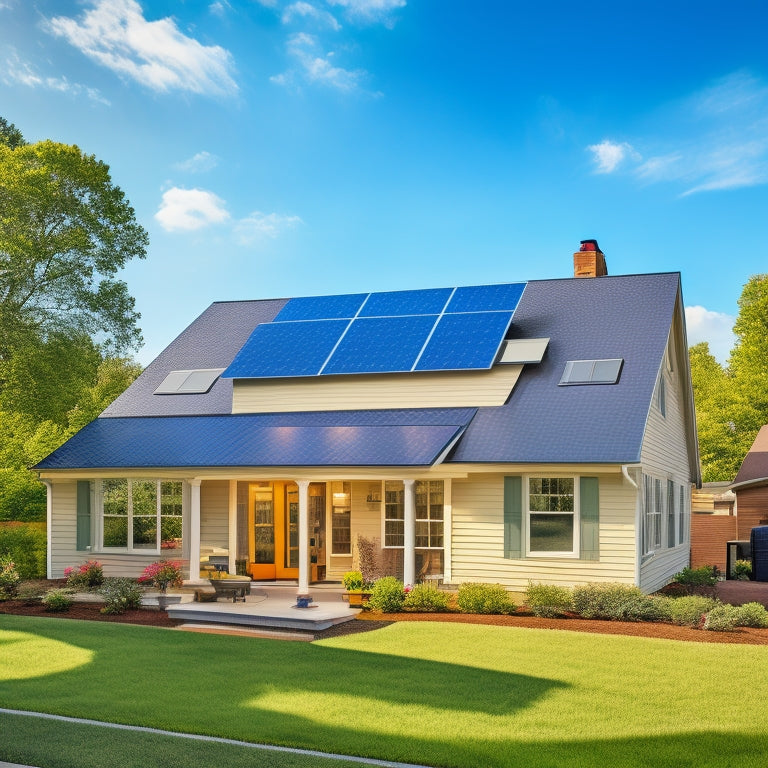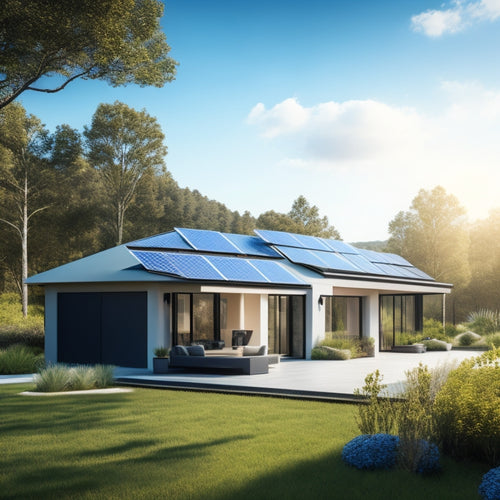
What to Expect From Home Solar Panel System Installation
Share
As you prepare to install a home solar panel system, you'll need to assess your energy needs, evaluating past utility bills and identifying areas for potential savings. Next, you'll assess your home's suitability, considering roof orientation, size, condition, and potential shading. You'll also choose a qualified installer, who'll guide you through system design and planning, permitting, and inspections. Installation day will involve clearing the area, designating parking, and confirming the schedule. After installation, you'll connect to the grid, monitor performance, and maintain your system to guarantee peak energy production. Now, it's time to investigate each step in detail.
Key Takeaways
- Understand your energy needs by reviewing past utility bills and identifying areas for optimization to select the right solar panel system size and type.
- Assess your home's suitability for solar panels by evaluating roof orientation, size, condition, and potential shading from trees and buildings.
- Choose a reliable installer with NABCEP certification, experience, and a strong reputation to ensure proper system design and installation.
- The installation process involves permitting, inspection, and installation, which can take several hours to days, depending on the system size and complexity.
- Regular maintenance is required to ensure optimal performance, including inspecting the system, cleaning panels, and monitoring energy production and consumption.
Understanding Your Energy Needs
Most homes use a significant amount of energy to power appliances, lighting, and heating/cooling systems. To understand your energy needs, you'll want to take a closer look at your energy consumption.
Review your past utility bills to determine your average daily energy usage in kilowatt-hours (kWh). This will help you identify areas where you can cut back and optimize your energy usage.
You'll also want to evaluate your energy usage patterns. Are you home during the day, or are you away at work? Do you have energy-intensive appliances like a pool pump or electric vehicle charger?
Understanding your energy needs will help you determine the right size and type of solar panel system for your home.
Assessing Your Home's Suitability
Frequently, homeowners overlook an essential step in the solar panel installation process: evaluating their home's suitability for solar panels.
You'll want to evaluate your home's energy-generating potential by examining its roof orientation, size, and condition. A south-facing roof with little to no shading is ideal, as it receives the most direct sunlight. However, don't worry if your roof doesn't meet these conditions; solar panels can still be installed on east- or west-facing roofs with some adjustments.
Next, you'll need to conduct a shading analysis to determine the impact of surrounding trees, buildings, and other obstructions on your solar panel system's performance. This analysis will help identify the best placement for your solar panels to maximize energy production.
Additionally, consider your roof's age, material, and structural integrity to guarantee it can support the weight of the solar panels. By evaluating your home's suitability, you'll be able to determine the best solar panel system size and configuration to meet your energy needs.
Choosing the Right Installer
Your solar panel installation expedition now hinges on finding the right professional to bring your renewable energy vision to life. This is a critical step, as a qualified installer will guarantee your system is designed and installed correctly, maximizing energy production and savings.
When researching potential installers, look for qualifications such as licenses, certifications, and experience. Check if they're certified by organizations like the North American Board of Certified Energy Practitioners (NABCEP).
Review their portfolio, including previous projects and customer testimonials. Pay attention to customer reviews on platforms like Yelp, Google, or Angie's List. A reputable installer will have a strong online presence and transparent reviews. Be wary of installers with low ratings or fake reviews.
Ask about their warranty and maintenance policies, as well as their process for handling issues or repairs. A reliable installer will provide clear, thorough support throughout the installation process and beyond.
System Design and Planning
You'll need a thorough site assessment to identify potential obstacles and optimize your solar panel installation.
A detailed energy efficiency analysis will help you pinpoint areas where energy savings can be maximized.
Based on these findings, a customized system design will be created to guarantee your solar panel system meets your specific energy needs and budget.
Site Assessment Needed
Conducting a thorough site assessment is crucial in determining the feasibility and potential of your home solar panel installation. This assessment evaluates your property's solar site considerations, guaranteeing ideal sunlight exposure for your system.
| Assessment Factor | Description | Impact on Installation |
|---|---|---|
| Roof Size and Shape | Determines the available space for solar panels | Affects system size and layout |
| Shading | Identifies obstructions from trees, buildings, or other features | Impacts energy production and system design |
| Roof Orientation and Slope | Affects the angle and direction of sunlight exposure | Influences system performance and energy output |
| Local Building Codes and Regulations | Guarantees compliance with local authorities | May impact system design, installation, and cost |
| Electrical Infrastructure | Evaluates the existing electrical system's capacity | Determines if upgrades are needed to support the solar panel system |
During the site assessment, your installation team will examine these factors to design a solar panel system that meets your energy needs and maximizes energy production.
Energy Efficiency Analysis
During the energy efficiency analysis, three vital components come together: a thorough understanding of your energy usage patterns, a detailed assessment of your property's solar potential, and the proficiency of a seasoned installation team.
This analysis is essential in determining the best solar panel system size and configuration for your home. By examining your past energy consumption patterns, the installation team can identify areas of inefficiency and opportunities for improvement.
They'll also assess your property's solar potential, considering factors such as roof size, orientation, and shading.
Here are three key aspects of the energy efficiency analysis:
- Energy consumption analysis: A review of your past energy bills to identify patterns and opportunities for reduction.
- Solar potential assessment: An evaluation of your property's solar potential, including its orientation, size, and shading.
- Incentive identification: A determination of the solar incentives you're eligible for, such as federal and state tax credits, to maximize your savings.
Customized System Design
Your energy efficiency analysis serves as the blueprint for a customized system design, where a seasoned installation team crafts a personalized solar panel system to meet your unique energy needs. This involves selecting the most suitable solar panel types for your roof, considering factors such as energy output, durability, and aesthetics.
The team will also assess your energy storage needs, determining whether a battery backup system is necessary to guarantee a stable power supply during outages or at night.
The design process involves a thorough review of your energy usage patterns, roof layout, and local building codes. The installation team will then create a detailed system design, complete with precise calculations and specifications for the solar panel array, mounting system, and energy storage components.
This customized approach guarantees that your solar panel system is optimized for maximum energy production and efficiency, while also meeting your specific energy needs and budget constraints.
Permitting and Inspections Process
You'll need to obtain necessary permits from your local government before installing your home solar panel system.
It's crucial to schedule inspections ahead of time to guarantee a smooth process and avoid potential delays.
Obtaining Necessary Permits
The project timeline hinges on securing necessary permits, an essential step that involves steering through local authorities and guaranteeing compliance with regulations.
You'll need to submit a permit application, which typically includes plans and specifications for your solar panel system. This guarantees that your installation meets local building codes and electrical standards.
To obtain necessary permits, you'll need to:
-
Review local regulations: Familiarize yourself with local ordinances and building codes that govern solar panel installations in your area.
-
Gather required documents: Collect all necessary documents, including your solar panel system design, electrical diagrams, and structural plans.
-
Submit your permit application: Submit your application to the relevant authorities, along with the required fees, and wait for approval.
Scheduling Inspections Ahead
With your permit application submitted, attention now shifts to scheduling inspections ahead. This important step guarantees your solar panel system meets local building codes and regulations.
You'll need to coordinate with your local building department to schedule a series of inspections, which typically include a pre-construction inspection, a mid-construction inspection, and a final inspection.
It's essential to understand inspection timelines to avoid project delays. Your installer should provide a detailed project schedule, including inspection dates and timelines.
Be sure to ask about the inspector's qualifications and certifications, confirming they've the necessary knowledge to evaluate your solar panel system.
When scheduling inspections, consider the inspector's workload and availability to minimize delays. Your installer should handle the logistics, but it's important to stay informed throughout the process.
Passing Final Inspection
Successfully maneuvering the permitting and inspections process culminates in the final inspection, a critical step in confirming your solar panel system meets local building codes and regulations.
This inspection verifies that your system is installed correctly, safely, and meets the required passing criteria.
During the final inspection, the inspector will review your system's electrical connections, mounting, and overall installation quality.
Be prepared to address common inspection issues, such as:
-
Improper electrical connections: Verify all electrical connections are secure, meet local electrical codes, and are protected from environmental elements.
-
Inadequate mounting: Confirm that your solar panels are properly secured to your roof, and the mounting system can withstand local weather conditions.
-
Incorrect system labeling: Verify all system components are properly labeled, including warning labels, instructional labels, and electrical ratings.
Installation Day Logistics
Coordinate with your solar panel installation team to confirm the installation schedule, guaranteeing you're prepared for the big day. This is essential to guarantee a smooth installation process.
You'll want to review the installation timeline, which typically takes several hours to a few days, depending on the complexity of your system. Your installation team will provide a detailed schedule, so you know what to expect.
Before the installation day, go through this preparation checklist:
| Task | Description |
|---|---|
| Clear the area | Make sure the installation area is free from debris and obstructions |
| Parking and access | Designate parking for the installation team and make sure easy access to the installation site |
| Utilities | Inform your utility company of the installation and schedule a meter change, if necessary |
Panel Installation and Testing
Your preparation is complete, and the installation team arrives on site. They'll begin by evaluating your roof's condition, confirming it can support the solar panel system.
Next, they'll install the necessary mounting hardware, taking care to secure it firmly to your roof. The type of panel you've chosen will influence the installation technique used. For example, thin-film panels may require a different installation method than crystalline silicon panels. Your installation team will be familiar with the specific requirements of your chosen panel type.
Here are the key steps involved in the installation and testing process:
- Panel installation: The installation team will carefully place the solar panels on your roof, connecting them to the mounting hardware.
- Electrical connections: The team will make the necessary electrical connections, confirming the system is safe and functional.
- System testing: The installation team will test the system to verify it's producing power efficiently and safely.
Once the installation and testing are complete, you'll be one step closer to utilizing the power of the sun and reducing your reliance on the grid.
Net Metering and Connection
With the solar panel system installed and tested, you're now ready to connect it to the grid and start generating electricity. This connection process involves net metering, a system that measures the electricity your solar panels produce and feeds any excess back into the grid.
You'll need to meet specific connection requirements, including installing a net meter and obtaining approval from your utility company.
The net metering benefits are substantial. You'll receive credit for the excess energy your system produces, which can offset your energy consumption during periods of low sunlight or at night. This means you'll only pay for the net amount of energy you consume from the grid.
Additionally, net metering allows you to take advantage of time-of-use rates, where you're charged differently for energy consumption during peak and off-peak hours.
Ongoing Maintenance Requirements
As your solar panel system begins generating electricity, it's essential to guarantee it operates at peak efficiency over its lifespan, which can range from 25 to 30 years or more.
To achieve optimal performance, you'll need to perform routine maintenance tasks.
You'll need to:
-
Regularly inspect your system: Keep an eye out for signs of wear and tear, such as loose connections or damaged panels.
-
Clean your solar panels: Dust and debris can reduce energy output, so use gentle cleaning techniques to keep your panels free from obstructions.
-
Monitor system performance: Keep track of your energy production and consumption to identify any potential issues. Performance monitoring allows you to pinpoint problems and schedule maintenance accordingly.
Frequently Asked Questions
Can I Install Solar Panels on My Roof With Asbestos Shingles?
You'll need to contemplate asbestos removal before installing solar panels on your roof with asbestos shingles, as it's a hazardous material; instead, opt for safe roofing materials, ensuring a secure and efficient solar panel installation process.
Will My Homeowner's Insurance Cover Solar Panel System Damage?
You'll likely need to add a rider to your existing policy or purchase a separate solar panel insurance policy to guarantee damage coverage, as standard homeowner's insurance might not cover solar panel system damage or malfunctions.
Are There Any Solar Panel System Warranties Available?
As you venture into the world of solar power, you'll find that most manufacturers offer an installation warranty, covering defects and workmanship for 10-25 years, and a performance guarantee, ensuring your system meets energy output expectations.
Can I Monitor My Solar Panel System's Performance Remotely?
You'll have access to remote monitoring, enabling you to track your solar panel system's performance in real-time, receiving alerts and updates on energy production, consumption, and any potential issues, giving you complete control and visibility over your system's operation.
Are There Any Local or State Incentives for Solar Panel Installations?
You'll be happy to know that you're eligible for federal tax credits and renewable energy grants, which can greatly offset the cost of your solar panel installation, making it even more affordable and increasing your energy independence.
Conclusion
As you flip the switch on your new home solar panel system, imagine the sun's rays dancing across your roof, converting light into energy, and savings into your pocket. The expedition's end is just the beginning - a path to energy independence, lower bills, and a smaller carbon footprint. With your system humming along, you'll be basking in the glow of a brighter, more sustainable future.
Related Posts
-

Solar Power Savings for Environmentally Aware Consumers
Switching to solar power lets you drastically cut your carbon footprint while saving money in the long run. Each kilo...
-

Eco-Friendly Energy Storage Systems for Houses
Eco-friendly energy storage systems for your house let you capture and use renewable energy efficiently. You can choo...
-

Cost-Effective Solar Solutions for Rural Homes
Cost-effective solar solutions can alter your rural home by enhancing energy independence and slashing utility bills....


